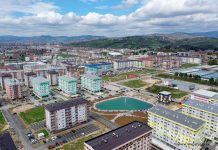For the purpose of memorialization of an extremely important factor when it comes to the protection of cultural and historical heritage, during the previous year the City of East Sarajevo started a series of activities with the aim of preserving and promoting the history of the medieval period. Recognizing the priority of systematization and cataloging of medieval manuscripts, as part of her research work, medievalist, PhD student and employee of the East Sarajevo City Administration Svjetlana Samardžija, when dealing with medieval church history came across a very important liturgy book containing chronicles, known as the Sarandapor Chronicle.
A SEVEN-CENTURY-OLD LITURGICAL-CHRONOLOGICAL BOOK
It is about the seven-century-old Liturgy – Chronicle, which has been in the National Museum of Bosnia and Herzegovina since the middle of the 19th century.
„We learned about the existence of the book through the blessed Metropolitan Amfilohije of Metropolitanate of Montenegro and the Littoral, who himself was a great lover of history and for whom the history was very important“, points out Svjetlana Samardžija, adding that the Chronicle is filed in the National Museum as „Liturgy“, and that it is better known as the Sarandapor Chronicle.

The Sarandapor Chronicle was created in Kriva Palanka in the Joakim Osogovski – Sarandapor Monastery, in present-day North Macedonia. At the end of the manuscript is the Chronicle which dates back to the 16th century, written in the Old-Slavic script, while the Liturgy is written in the Church-Slavic language.
Very little is known about the Liturgy and the truth about how it got to Sarajevo still remains uncertain. A short chronicle from the 16th century, which is in the files of the National Museum of Bosnia and Herzegovina in Sarajevo, was written, as Samardžija confirms, „in a large irregular half“. The last page has a gap in the middle, but it can be read and understood, and it is concluded that its chronological notes go back to 1512, and three chronicle notes containing information about the history of the Sarandapor monastery have been inserted into the text.
According to Svjetlana, the Liturgy written in legible Church-Slavic and the Chronicle written in Old- Slavic are covered with wooden leather covers, which confirms the observations of Ćiro Truhelka, who explains that the end of the manuscript is illegibly written.

DATA OF LJUBOMIR STOJANOVIC AND MANUSCRIPT CHRONICLE OF ĆIRO TRUHELKA
During his lifetime, the Serbian historian Ljubomir Stojanović collected data on precious old Serbian manuscripts and in his work „Old Serbian genealogies and chronicles“ in 1927, he also mentioned the Sarandapor Chronicle. Later transmissions of the Sarandapor Chronicle, as historians claim, were left without the conclusion of its first publisher, Ćiro Truhelka, which he named „The Manuscript Chronicle from the Beginning of the 16th Century„. „Perhaps we can guess from it that the writer lived there, because of the fact that the chronicle, which normally only lists the most important historical facts, mentions an unimportant place in two cases. That place is the Sarandapor monastery“, writes Ćiro Truhelka.
In his „Manuscript Chronicle from the Beginning of the 16th Century“, Truhelka notes that the Liturgy was written on paper in a beautiful script. „The National Museum of Bosnia and Herzegovina owns an old manuscript, the so-called Liturgy, and two chapters are attached at the end of the same book“, it is stated in the manuscript, and Truhelka writes that he could not recognize the writer anywhere in the text and that the book was presented to Teofan Gerasim, the Metropolitan of Skopje, the abbot of the Uvac monastery, in 1690.

„In our chronicle, which, apart from the back page where half the page has been torn off so only the first quarter of the final 20 lines has been preserved, describes the events up to the year 1510, so it must have been written then or a year after“, noted Truhelka, explaining that in the chronicle, which contains the most important „historical facts“, the Sarandapor monastery is mentioned in two cases, and that, as he stated, it can be inferred that the writer lived there.
„That is the place of the Sarandapor monastery, which Emperor Mehmed visited in 1463, and where Abbot Arsenije died in 1489,“ says Truhelka.
FOLK TRADITION
In folklore, it is mentioned that the relics of Saint Joakim Osogovski „stunned“ the great Ottoman army, when the army and the grand vizier in one of the campaigns alienated the holy relics from the monastery and on that occasion they became speechless. As written in traditions, the Sultan in Constantinople, after the Grand Vizier informed him about the event, protected the monastery with his imperial insignia, which is still located above the door of the monastery, while the same insignia can be found on Hagia Sophia.
The Sarandapor monastery was written about in Šafarik’s Serbian chronicles and stated that it was dedicated to the „holy father Joakim“, and that one part was built by King Milutin.

THE METROPOLITANATE OF MONTENEGRO AND THE LITTORAL KNOWN WITH THE CHRONICLE
Milena Martinović, consultant conservator at the Cetinje National Museum and expert on the Cetinje Annals, explains that the Bulgarian scientific scene is also familiar with the old manuscript and that it is mentioned in several books and texts. Martinović, as part of the International Scientific Conference on the Crnojevićs and Bušatli Viziers, organized in 2017 under the auspices of the Metropolitanate of Montenegro and the littoral, mentions the Sarandapor Chronicle and emphasizes the importance of its digitization for understanding the special group of Stojanović Annals, which include the Kiev and Cetinje Annals. An interesting feature by which, as Martinović adds, the chronicle differs from today’s known works of the same genre, are the added stories about the religious conversion of Bulgarians and Russians.
THE CITY OF EAST SARAJEVO IS READY TO HELP THE PROCESS OF CONSERVATION AND DIGITALIZATION OF THE CHRONICLES
The City of East Sarajevo, aware of the importance of this important historical work, both for linguists and for historical sciences, as well as for the preservation of the cultural and historical heritage of our country, is ready to help the process of digitization and conservation of the Sarandapor Chronicle.
The city of Istočno Sarajevo is familiar with the work of the National Museum Library in Sarajevo, the dedication of the conservators and librarians who work dedicatedly to preserve historical materials and historical sources, and we hope that we will find the understanding of the authorities and together save this important document from oblivion.
/City of East Sarajevo/





